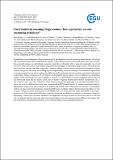Por favor, use este identificador para citar o enlazar a este item:
http://hdl.handle.net/10261/167719COMPARTIR / EXPORTAR:
 SHARE
BASE SHARE
BASE
|
|
| Visualizar otros formatos: MARC | Dublin Core | RDF | ORE | MODS | METS | DIDL | DATACITE | |

| Título: | Uncertainties in assessing tillage erosion – how appropriate are our measuring techniques? |
Autor: | Fiener, Peter; Deumlich, Detlef; Gómez Calero, José Alfonso CSIC ORCID ; Guzmán, Gema CSIC ORCID; Hardy, Robert; Jague, Emilien A.; Quinton, J. N.; Sommer, Michael; Van Oost, Kristof; Wexler, Robert; Wilken, Florian | Fecha de publicación: | 2017 | Editor: | European Geosciences Union | Citación: | Geophysical Research Abstracts 19: EGU2017-6425 (2017) | Resumen: | In undulating arable landscapes tillage erosion is one of the dominant processes initiating lateral transfer of soil and soil constituents. Especially, in relatively dry regions, where tillage erosion can be much larger than water erosion, the associated changes in soil hydraulic properties might have substantial effects upon the sustainable use of soil resources. There have been some studies using different techniques to determine tillage erosion which build the basis for tillage erosion modelling approaches. However, tillage erosion is rather understudied compared to water erosion. The goal of this study was to bring together experts using different techniques to determine tillage erosion in an experimental set-up and to analyse the different results and assess the uncertainties associated with typical model inputs. Tillage erosion on a 50 x 10 m plot was determined after two phases of seven tillage passes performed within a week (simulating 10-14 yrs of tillage). As tracers, two different micro-tracers (magnetite mixed with soil and fluorescent sand) and one macro-tracer (passive Radio-Frequency Identification (RFID) transponders; dia. 3 mm, length 20 mm) were used. Moreover, tillage induced changes in topography were spatially determined for the entire plot with two different terrestrial laser scanners and an UAV-based structure by motion topography analysis. Topography changes were also evaluated at 12 points using buried concrete flagstones as reference. A preliminary analysis of tracer movement indicates substantial differences in tillage induced translocation depending on type of tracer. While the mean translocation of the RFIDs was 0.47 m per pass the mean movement of the micro-tracers was 0.70 m. Substantial differences were also found for the different techniques to determine changes in topography. Overall the experiment underlines the importance of tillage erosion for the lateral transfer of soil and soil constituents, but also shows the large discrepancies between measurements based on different techniques. The latter introduces substantial uncertainties in any existing tillage erosion modelling approach. | Descripción: | Trabajo presentado en la European Geosciences Union General Assembly (EGU 2017), celebrada en Viena del 23 al 28 de abril de 2017. | URI: | http://hdl.handle.net/10261/167719 |
| Aparece en las colecciones: | (IAS) Artículos |
Ficheros en este ítem:
| Fichero | Descripción | Tamaño | Formato | |
|---|---|---|---|---|
| tillage_erosion_Fiener.pdf | 36,19 kB | Adobe PDF |  Visualizar/Abrir |
CORE Recommender
Page view(s)
398
checked on 16-abr-2024
Download(s)
311
checked on 16-abr-2024
Google ScholarTM
Check
Este item está licenciado bajo una Licencia Creative Commons

